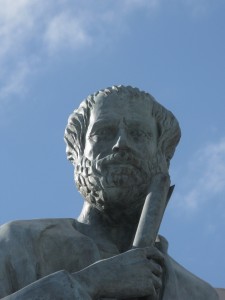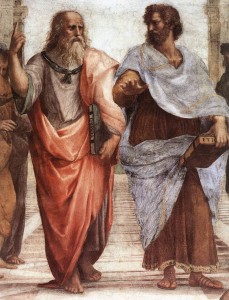It’s All Greek to Me

Decimated and exhausted, the Greek army was stymied again and again outside the walls of Troy.
“Ah fudge,” the generals exclaimed. “We’re stymied.”
If they couldn’t figure out a way inside, they would be ruined.
One general, Odysseus, was clever enough to think up a strategy to get his troops inside. Hidden within a large, elaborately constructed Trojan horse, the men would be voluntarily wheeled inside the gates by the Trojans, who would think it was super chic and would really tie the room together.
All they needed was to be let in. Then victory was certain.
Sound familiar? Sure it does. This is the way many have thought about site traffic for years.
Many think that if they could just get people to visit their website, to let them in for just a moment, then their business would take off. They obsess over SEO rankings and the click-through rates on promotional campaigns. They crack a wry, Odysseus-esque grin (whatever that looks like) as they watch the traffic numbers rise. They have breached the web-browsing wall.
But what’s true in war is not always true in marketing—in fact, thankfully not.
Content marketing is not a Trojan horse. Neither is your position one ranking.
And without a website designed for converting visitors into customers, then the very moment you’ve made your way through their browsing defenses, is the same moment they vanish completely, and all of that site traffic is a wash.
In the end, your site’s design is what turns your marketing sweat into the final, and arguably, most important variable in your business’ digital conversion equation.
Web Design Converts Visitors

So how should you design your website?
Think about your goal: if you want a visitor to stay on your website and click a button, fill out a form, or take some kind of action, then you are dealing in the art of persuasion.
And instead of emulating the Greek war heroes, you should consult the Greek philosopher, Aristotle.
As the father of rhetoric, Aristotle broke down the three main elements of an effective argument: ethos, pathos, and logos, or more commonly, ethics, emotion, and logic.
While great orators and essayists have exhaustively studied these principles, great web designers of the modern era should also take note.
Because every communication on your website, from the color of your logo to the structure of our information, is influenced by rhetoric.
The Principles of Rhetoric in Web Design
How do these three principles apply to web conversion tactics?
Ethos = Earn Trust = Validate the Click
The way Aristotle saw it, an effective writer or speaker would first establish that he actually knew what he was talking about. Any amazing speech would be cut off at the knees if the audience was skeptical of the source from the start. Articulating your unique authority to speak on the subject would earn trust from the audience and set the table for the rest of the argument.
In the same way, your website should immediately set the table for any potential conversion by showing the visitor that your site is exactly what they were looking for. There is a sort of blind faith attached to clicking a link, no matter the source. You have a handful of seconds from the moment they blink their eyes open on your site to convey that, “Yes, dear traveller of distant web pages, I am exactly the site you intended to appear, and I am a trustworthy bearer of the information you seek.”
These landing pages should anticipate where the visitor was coming from and provide clear, visible indicators that convey your relevance and trustworthiness within seconds. This is not the time or place to write that novel about your business origins. Save that for a page outside the conversion funnel.
Logos = Appeal to Reason = Pique Interest
Humans possess the unique capacity to reason, and because of this, place a high value on its use. Any argument that takes pains to prove itself logically earns the respect and attention of its audience, because ultimately, it shows that the speaker is willing to hold his case up to the light of absolute truth, simultaneously complimenting the listener’s intelligence in assessing it. This appeal to reason then stakes a speaker’s success on high ground.
If your website’s offer, service, etc. can quickly appeal to someone’s sense of reason, then you’ve appealed to their highest, most reliable sense, and likely piqued their interest.
In this case, it helps to take a step back from all the spreadsheets, goals, and marketing taglines and highlight a central, simple reason why your offer just flat makes sense.

Pathos = Tap into Emotion = Compel Action
Here’s the thing — we aren’t simple creatures and we don’t just act with reason. Aristotle admitted that despite our fancy slacks and use of protractors, we’re all still animals. Our irrational passion, that deep-seated emotion, often feels more true than anything and mixes with the more noble reason to influence our decisions and convictions pretty heavily.
This is probably why so many people still buy new cars. It doesn’t make sense. It just feels good. There’s something to be said for the persistent pagan element that factors into so much of consumerism’s pleasure.
Tap into your visitor’s emotions at all points of your website, but especially the last stage of your conversion funnel. Focus on the benefit of your offer, rather than the features and doohickies that are attached to it. Remind them how and why this will actually be good for them. Nevermind the price or the special widget they get. We all just want that new car smell.
We’ve Only Just Begun
This is an introduction to what we should all think about when designing our websites to achieve our intended business goals (assuming its some sort of conversion and not just branding).
And while a lot of what’s been discussed seems to touch on information architecture and copywriting more than aesthetic design, there is a whole enchilada to unravel within the school of visual rhetoric that shapes the choices we make with colors, shapes, and art that can be applied to the above framework just as easily.
For a deeper look at that and other design specifics, stay tuned for part 2 of this exploration into web design as the final piece in the digital marketing puzzle.

